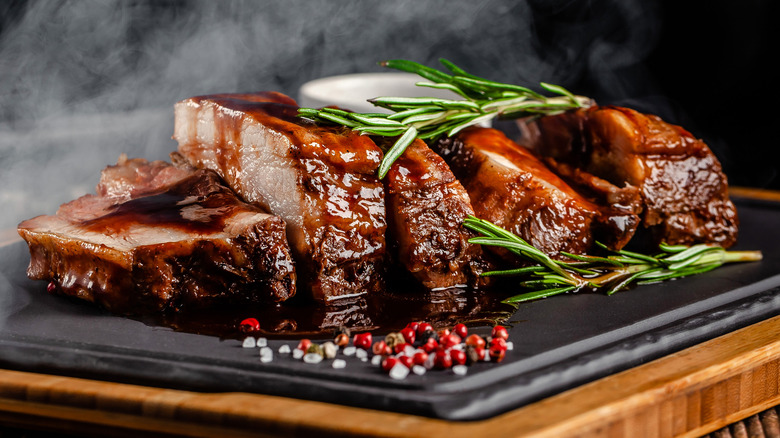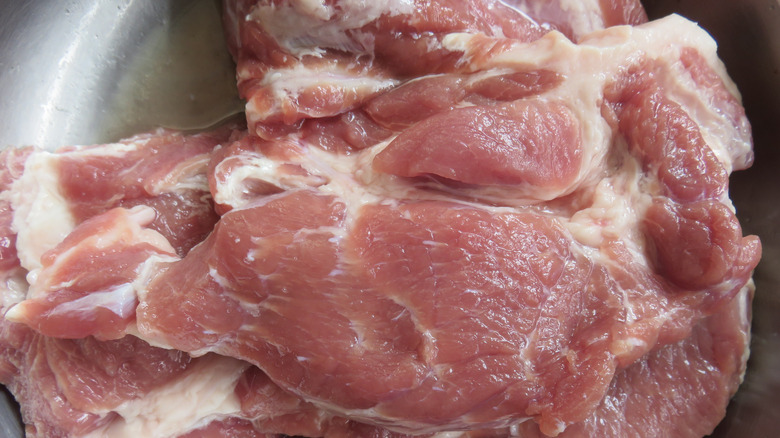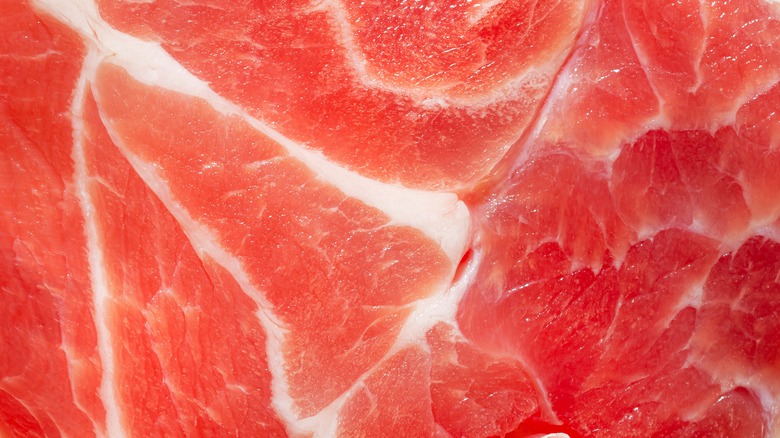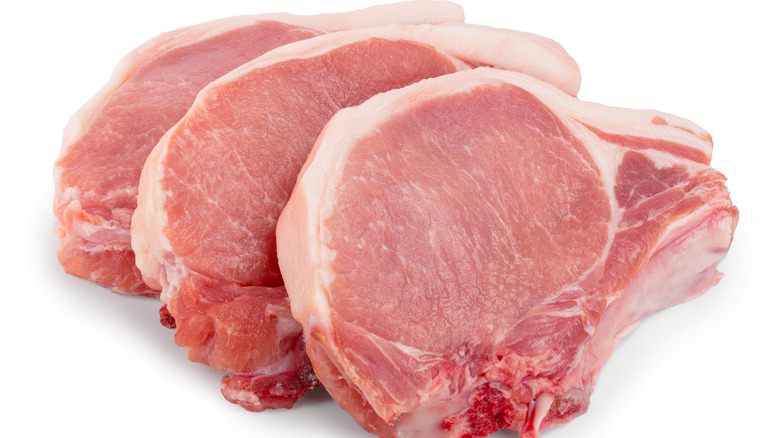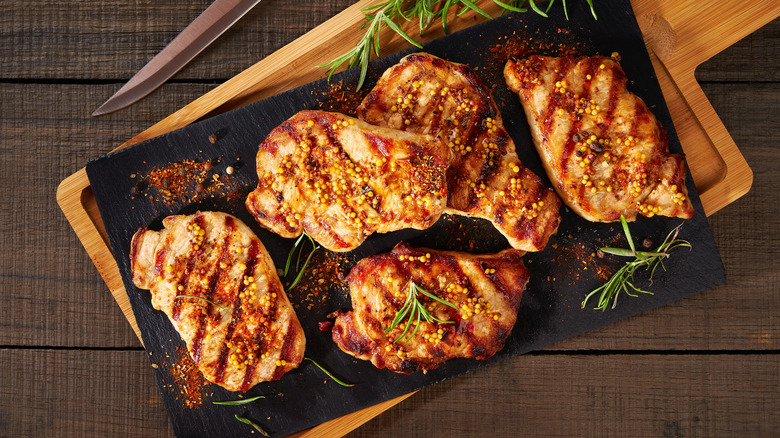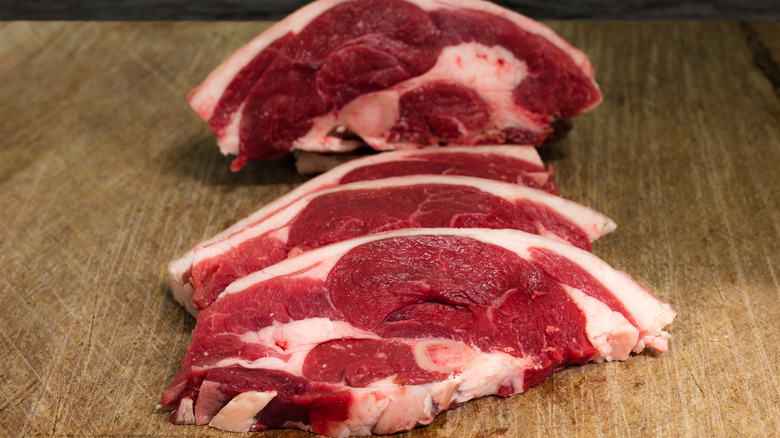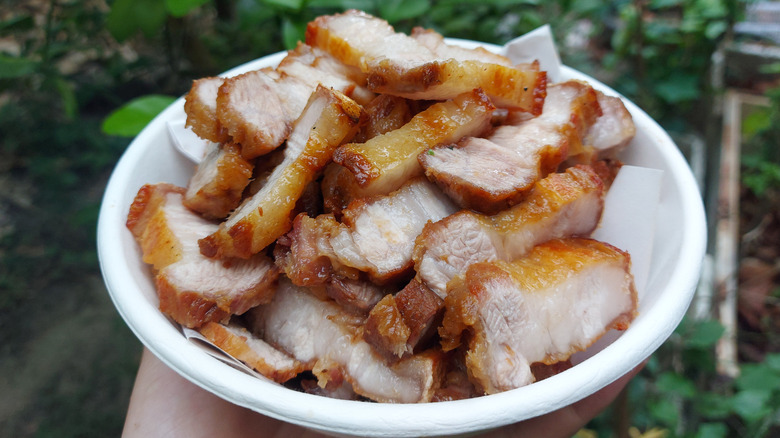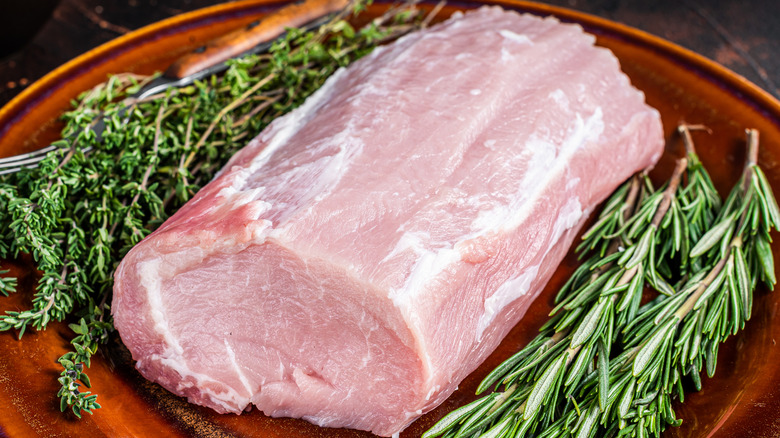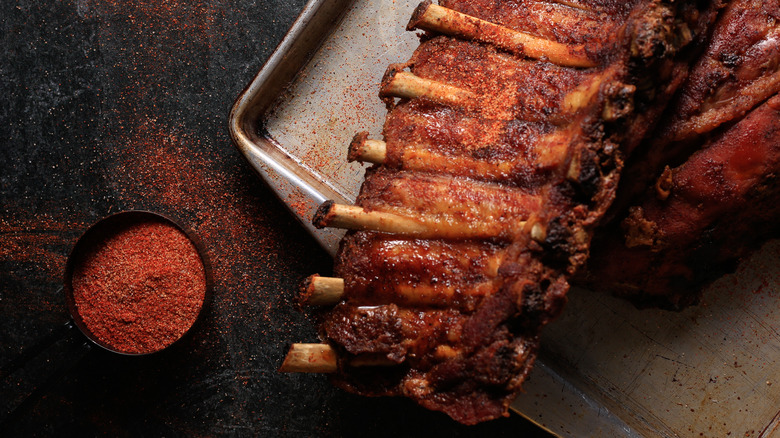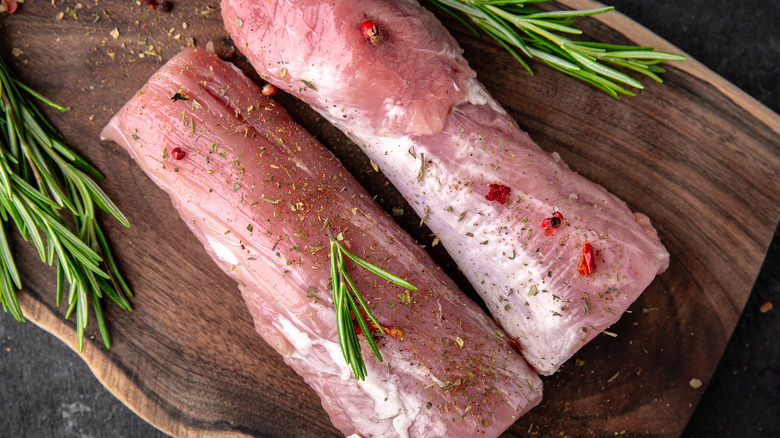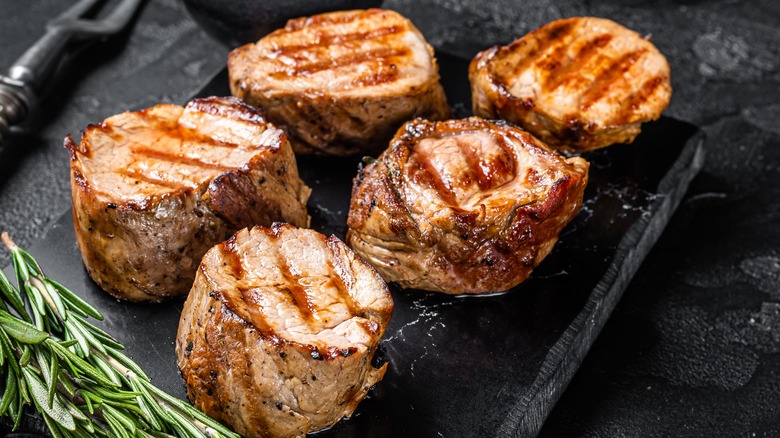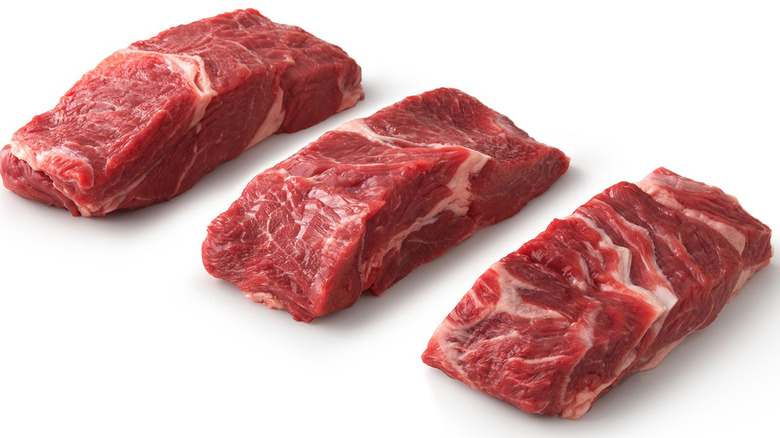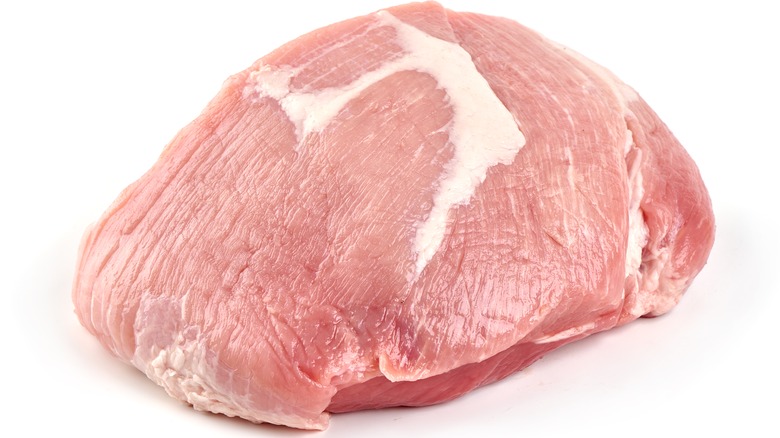The Absolute Best Cuts Of Pork To Grill
Summer's here and grilling is tailored to the season: a blazing, often-smoky cook station is much more welcome outdoors, and anything you grill is going to be served up quickly enough for friends that you can get back to the party rather than fussing over a flame all evening. When you grill, you're talking high heat, quick cook times, and whole muscle without a lot of connective tissue. Pork is ideal for this method, as so much of the animal is juicy, flavorful, and fast-cooking to the USDA's recommended internal temperature of 145 degrees Fahrenheit.
Whereas barbecue thrives on convective heat from an indirect source (per FoodFireFriends), in grilling you're working with radiant and conductive heat acting on meat cooked directly over the heat source. For this reason, it's a good idea to get the grill grate itself nice and hot first, so you can sear some Maillard marks on that cut before it cooks through.
Working with thin to medium cuts at fast cook times, you're not going to find any smoke rings in your meat. If you want smoky flavor, you'd better use charcoal and/or wood chips, and prepare for surface-level smokiness. That said, it's a smart idea to familiarize yourself with various smoke types that you do and don't want, or else risk ruining a great piece of meat with bitterness. Once you've got that in mind, you're ready to take on the absolute best cuts of pork to grill.
Pork blade steak
While abundant connective tissue makes the shoulder a lead candidate in the best cuts of pork for smoking, this back piece derived from the pork shoulder primal cut is an exception for the grill, thanks to its relative thinness and reasonably fatty flavor. BBQ Host notes that the connective tissue on the more-flavorful pork steak will have an easier time reaching breakdown temperatures at the typical one-inch thickness.
That same fat, Masterclass says, will protect it from drying out quite so easily as a pork chop. Though it is recommendation enough, you will also likely save money when buying pork steaks since they are a little less in demand despite being boneless. With all those advantages in mind, why isn't this the cutlet of choice? It's a combination of reasons, per BBQ Host. In part, the shoulder blade section yields steaks more plentifully than the loin offers up chops — but also, people are simply used to picking pork chops when they want grilled pork for dinner.
Whatever the reasons, let this cut guide you to a great dinner without busting the bank. The National Pork Board recommends cooking pork steak for about 10 minutes on medium-high heat, and you'll have a seared slab of pig that's perfectly moist in the middle. (Don't forget to flip!)
Pork blade chops
Also called pork shoulder chops, these are adjacent to the blade steak at the shoulder end of the loin. Pork loin dominates this list of grillable cuts, because, as longtime pork experts S. Clyde Weaver point out, "high on the hog" is the most tender part of the pig, with scant amounts of tough connective tissues. Loin cuts also often have a nice, discrete strip of fat for moisture and flavor. That fat is more prevalent in blade-end loin chops, making them an obvious choice for juicy grilling — although, Frontline Foods Queens writes that the connective tissue found near the shoulder also makes this cut a better candidate for slow-cooking than other loin chops. Like its sister blade steak, pork shoulder chop is a forgiving cut.
As Difference Guru says, the blade, center loin, and sirloin are all smaller divisions of the primal loin cut, and each section has its own types of chops. Each has a specific breakdown into sub-cuts of the loin. This can get confusing quickly, though loin chops tend to cook up similarly (despite there being more flavor at the shoulder and sirloin ends).
Cooks Illustrated lists these chops in order from bow to stern: blade chop, rib chop, center-cut, loin chop, and sirloin chop — the last of which they solidly do not recommend. Sirloin is faulted for its lack of flavor, and it isn't easy to cook properly. Save that cut for braising, or heed our advice and give it a long marinade.
Rib chop
Often sold as rib cut chops, pork chops end cut, or even pork ribeye steaks — but very distinct from any rack of ribs — this segment of the rib section of loin is shaped somewhat like a bird's head and beautiful to behold with its ring of fat and pink meat. You can also find them boneless, but that handle of bone feels like a promise from the kitchen that you're in for a delicious meal.
Allrecipes calls the rib chop perfect for grilling and recommends a dry brine on a wire rack to give the surface a completely dry exterior before it hits the grill running. Few (if any) cuts compare to the rib chop's ability to sear a mouthwatering Maillard reaction, for which a dry surface is a must. Additionally, the thickness of rib chop is a moisture-retaining benefit on the inside as the outside browns over high heat.
If you follow our advice to team pan-seared pork chops with apple (and some sage), then you'll hit one of pork's most classic flavor combinations. We recommend turning rib chops often to render the fat evenly as you create lovely opportunities for a crusty exterior. Perched over a warm grill sounds like a great way to spend a chilly autumn afternoon with these fall flavors.
Loin chop
The loin chop is probably what people most commonly think of when they hear the blanket term "pork chop." Despite the name, the loin is distinct from the tender; you can frequently enjoy eating a loin chop, a center-cut chop, pork porterhouse, or top loin. It is a classic, common, T-shaped pork chop that The Meat Source calls both the most popular and versatile cut of pork. Just like a T-bone or porterhouse steak, it has a tenderloin side (the equivalent of the filet mignon in beef) and a loin side (equal to the strip).
Per My Food & Family, the New York cut, just like a New York strip steak, is the loin minus the tenderloin and is perhaps even better for the grill, as it cooks quickly and more evenly without the more vulnerable muscle. These can be sold on or off the bone.
Whichever you choose, these low-fat chops are prone to dryness. Cook them high and fast, then let the internal temperature continue to rise off of direct heat. Do it right, and you'll enjoy one of the most satisfying meals out there.
And if you do err into dry territory, don't beat yourself up. Modern Farmer says pigs have been getting leaner and more muscular every generation, thanks to market forces that prioritize return on investment over juicy flavor. You're up against a tougher cooking challenge than your grandparents. At the end of the day, you're still enjoying pork.
Chump chop
You might think of this pork cut as the rear-end version of the blade steak. While the chump chop is derived from the different primal cuts in Australia or the United Kingdom, you may find or request it at specialty and fine butchers or grocers in the United States. Pounce on it when you do. The chump chop is as easy to cook as it is hard to find.
And don't fret if you're an American looking to explore the culinary landscape. If you know what you're looking for, you can easily make your own chump chop by carving off the sirloin end of a boneless loin roast. Your Meat Guide says it's also possible to find this section on leg cuts as a boneless roast rather than a chop.
However you source it, you'd be a chump yourself to pass by the opportunity. The thick strip of fat gives it immense flavor. The rind, when commonly left on, provides satisfying texture and chew, and the meat itself is tender and fine. The Ginger Pig mentions that the slightly marbled fat on this cut will give you more leeway when cooking, a boon given the variables in temperature accuracy and consistency that make grilling such an alluring challenge. But as it does contain connective tissue, you'd be smart to slice it thinly when you intend to cook it high and fast.
Crackling
When your coals are blasting, make this blistered hide as a snack for people to savor while they wait for the longer cuts to come out. Perfectly made for grilling, the trimmed belly will puff and crisp up while the melting fat surface fries the hide. Crackling is a great treat to pop on the grill quickly. With a quick seasoning, the warm, bubbly rind nearly falls off the grill for a quick appetizer while other cuts cook longer.
To get to pork rind heaven, you will want to aim for a few features: dry, tight, and maximized surface area. FoodFireFriends recommends several techniques to get there. Tenderize with a mallet, score the skin crosswise, blanch it in boiling water to make it contract, pat dry, dry-brine it with salt, and let it air-dry in the fridge. The Online Grill agrees with those steps while also coming down determinately in favor of an olive oil rub since the hydrophobic substance can quickly bring surface temperatures up to the frying range.
Pork fat has a smoke point of 375 degrees Fahrenheit, coincidentally the same temperature as extra-virgin olive oil. However, as the olive oil will be heating up while the lard is still rendering, you may wish to use regular olive oil, which won't oxidize till 425 Fahrenheit. There are other oils with even higher smoke points but remember that the light brushing of oil is not a completely necessary step since the fat will be frying the skin for you.
Pork loin roast
The loin section is perfect for grilling despite its low-fat content because it's a slab of muscle. You can find pork loin roasts under numerous arrangements of the words "pork loin center-cut roast," as well as center-cut rib roast (if the bone is still included). However, be careful not to confuse them with tenderloin roast. All are recognizably loaf-shaped. If you find one with a fat cap on, that's preferable.
The pork loin roast is ideal for brining, followed by a marinade of whole-grain mustard. Salting in advance will curtail the meat's tendency to dry out, says Cave Tools. While most recommend grilling the loin roast over indirect heat, Our Everyday Life cautions that pork loin roast runs the risk of drying out even at the USDA's revised recommendation of 145 degrees Fahrenheit. Moderate heat is recommended, and Cook the Story explains how long, slow cooks actually toughen up this lean meat. You may wish to alternate between direct and indirect flipping as you cook.
Follow their instructions to let the loin rest at least 15 minutes before serving for numerous benefits, such as moisture returning to equilibrium even as the cut finishes cooking the meat. Doing so will also make carving easier, as the proteins settle into a stronger state when heat stops moving through them. Eat This, Not That agrees and advises a pre-cook rest on the counter. Avoiding this can leave the center cold while the exterior starts to overcook.
Baby back ribs
Baby back ribs are rich with meat but lacking in fat, so Cook's Illustrated cautions that these top-rib loin cuts are prone to dry out with the kind of long-cooking conditions that other ribs love. This is particularly true if you dry them to remove the membrane. According to Cave Tools' instructions for perfect grilling, you can cheat the evaporation reaper and still soften the connective tissue with a long cook in the slow cooker, though these are the rare BBQ cut that also loves high heat. Of course, you could always combine methods to enjoy it both ways: Ribs in the cooker until all the other food is ready, then a smoky, searing hot leap over the grill.
If there's a downside to baby back ribs on the grill, it's that cartilage won't break down by the time the meat cooks to perfection. But don't ditch the scraps and bones. Grilled ribs make a heavenly stock with smoky tones to it. Keep that slow or pressure cooker on the counter to make downright gelatinous byproduct — it won't even heat up your house to do so. Strain or freeze the liquid until winter to make a broth that rivals even the best ramen restaurants, or use it immediately as a spectacular soup base with rich grill flavor.
Pork belly
Is there a better part of the pig than the belly? Soft and fatty, the pork belly is rippling with flavor, even without curing it into bacon. Better still, it's a cheaper cut to come by and can please a whole crowd in just a few bites (and at low cost). While most BBQ enthusiasts will wail against the missed opportunity to make burnt ends (fair), we recommend spearing chunks of pork belly on kebabs. Food Republic says a bite of belly leaves a big footprint on any meal. Pair with vegetables — another argument in favor of kebabing it — as the fattiness elevates anything it touches. Suddenly, asparagus seems quite delicious.
For grilling this pork cut, Simply Happenings recommends using an intense sauce or seasonings that can go ten rounds with the fat and smoke. The combination will light up all the happy parts of your brain at first bite. Grilled pork belly is one of the richest tastes in creation, and it can definitely handle anything you throw at it, so put some sweet heat on that meat in the form of barbecue and hot sauces, vinegar, or any combination thereof. There's a reason bacon and dried dates go so well together. You can't go wrong when intensifying the aromatics and spiciness to your preference.
In fact, with the right marinade to tenderize and permeate pork belly, you'll be pulling these heavenly spears off the grill almost as soon as they land. For cooking times, Allrecipes recommends grilling for just three to five minutes per side.
Pork tenderloin
Technically, pork tenderloin is a roast, but few other roasts were ever made for speed like this one. This long, thin strip of incredibly soft meat cooks easily over high heat (just 15 minutes according to Iowa Girl Eats), which makes it a prime candidate for grilling. But beware: like the adjacent center-cut loin, pork tenderloin is a dangerous game (via National Pork Council). Tenderloin even rests quickly, at a mere three minutes by the Pork Council's recommendation. When grilling this pork cut, its very name is at stake, since the tenderness draws to this narrow strip of meat rather than the strong pork flavor. That said, it does pick up more taste if you can find the fairly common marbled specimen. You're well advised to marinade this one to infuse your own flavor profile.
Pork tenderloin is another must-brine cut if your marinade doesn't contain salt, but the juiciness is well worth the planning. Speaking of which, if your tenderloin came with the silver skin attached, it is worth the five minutes to remove it. You paid for tenderloin, not tender-but-also-tough-membraneloin.
You can also cut tenderloin into cylindrical rounds if you feel like flipping frequently and maximizing the sear on all sides. Tell your guests it's pork filet mignon as per Delighted Cooking, and let them think you've spared no expense to make this cookout a success. But beware that you will increase the risks along with the cooking time.
Pork tenderloin medallions
Thin enough to be a distinct cut, tenderloin medallions sear instantly and give an extra Maillard reaction crust on the grill grates — if you're a confident cook. These patties hail from the tenderloin, with a wonderful flavor, but heed Dominican Cooking's warning that they risk quickly drying into very tough bites. For this reason, tenderloin medallions are a popular cut to hammer even flatter into schnitzel, also called escalope (via Your Meat Guide).
When you grill your medallions, it's important you first pat them dry so that they sear immediately. As mentioned above, these low-fat cutlets can dry out in no time, so you don't want to wait to develop a Maillard crust. You don't want the moisture inside evaporating by the time the water on the surface does. Get 'em on the grill, then off as soon as both sides are seared — maybe even just one side if you're escalloping. Don't let it overstay a welcome when there's a perfectly good home waiting for this pork cut in your belly. We can't stress enough that medallions are pretty much done as soon as you get a sear on them. If you really know what you're doing, you can chase the double-sided char, but don't get greedy, or you'll pay the cost of overcooking.
Country-style ribs
Country-style ribs are not really from the rib section so much as the shoulder. As well as being boneless, Three Little Pigs BBQ remarks that many argue these are actually cutlets. It's a solid point, but we can do away with any debate by pounding these into schnitzel, as is often done. After that, it's just a matter of handling them with the same kid gloves as pork tenderloin medallions, albeit less risk, since they have a little more fat and some connective tissue. The real dynamic will be between softening that before the meat dries out, for which you would do well to brine them (via The Kitchen Professor).
To excel at grilling this pork cut — especially if you like them thick instead of flattened — follow The Mountain Kitchen's guide for bouncing between direct and indirect heat. A dry paprika rub is also recommended, which sounds heavenly, though a marinade is fine if you prefer your own seasoning. Another low-risk preparation is steam-cooking with a water pan, though we're here for the charred grill marks.
If you do marinade, be mindful of Foods Gal's guide to not overdoing it. The acids in a marinade risk making ribs mushy, and country-style ribs are more tender than "real" ribs. Stick to a three-day marinade at most, and consider that you'll likely hit a good flavor saturation before that. If your marinade has enough salt, skip a separate brining.
Shoulder (ground)
We know what you're thinking: grill a pork shoulder?! The poster child for slow-cooking? Sure, for intact shoulder the low-and-slow method is the way to go. But pork shoulder is also the best cut for burgers, a sure grilling food if there ever was.
St. Louis Magazine — that's a town that knows a thing about pork on the grate — recommends mixing shredded pork shoulder with cooked (read: less hydrated) vegetables to make a meatloaf-like mixture that will sear up perfectly for bun-sized burger servings.
Babaganosh emphasizes the meatloaf move, using home-ground pork shoulder in conjunction with oats to absorb the pork's delicious juices and egg to bind it all together. These make a great final flourish as the coals of the grill die down, cooking in just 10 minutes over medium-high heat. They also make the case that pork — particularly home-ground — means huge budget savings over beef, pound for pound.
If your butcher will grind it for you, great. Otherwise, there are a few caveats to avoid ruining the texture. Don't add salt until just before grilling, or the proteins really will turn into meatloaf. The Meatwave recommends just a couple of passes in the grinder, or you'll end up with smooth sausage meat rather than a burger. Finally, Weber says to get the diced, raw shoulder very cold to avoid mushing the meat.
